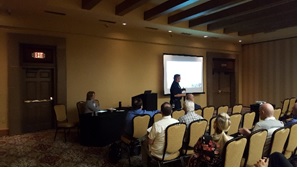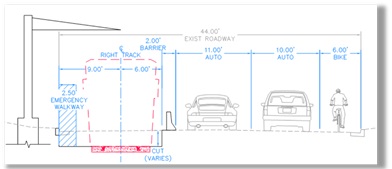By Renee Hoekstra, CVS – Vice President/President Elect, SAVE International
The SAVE International Arizona Chapter and by default, the SAVE Board of Directors, continues their endeavor to Promote, Advocate and Educate the Arizona Chapter of the American Public Works Association (APWA) members about the process and benefits of formal value engineering. APWA’s membership consists of local government agencies, towns, cities and counties, many engineering disciplines, and contractors in the delivery of public works projects.
The SAVE Arizona Chapter partnered with APWA to sponsor a half-day ABC’s of VE class at a cost of $25 per person, which will be donated to the APWA Scholarship Fund. We had 18 attendees, mostly from the government sector. The workshop was a huge success and we’ve generated some great interest in helping Pima County to develop a more formalized or structured program.
In addition, some other agencies expressed interest in understanding how to integrate VE into new Requests for Proposals for Architectural and Engineering services. This is a big win for VE. The class was led by current SAVE Vice President/President Elect and Arizona Chapter member, Renee Hoekstra, with additional instruction from Mike Bonar, also a member of the SAVE Arizona Chapter.
Additionally, APWA allowed SAVE two hour-long presentation slots in the conference. RHA, LLC had recently completed two very interesting projects in 2017, and these studies were presented with project stakeholders on behalf of the SAVE Arizona Chapter.
 The first presentation concerned the Town of Gilbert Public Safety Training Facility, which was a new combined police and fire training facility. This is a unique project because very seldom do fire and police share a training facility. The presenters included Susanna Struble, Assistant Town Manager, Rob Duggan, Assistant Fire Chief, and Renee Hoekstra for RHA, LLC. The VE Team had very little project information to begin with and had to develop a budget that could be presented to Town Council in order to obtain their approval before it could become a bond measure on the November 2018 ballot. VE was used to identify and finalize the entire scope, and to integrate the various stakeholders, which included Public Works, Capital Projects, Police, Fire, Parks and a Council representative for the Town.
The first presentation concerned the Town of Gilbert Public Safety Training Facility, which was a new combined police and fire training facility. This is a unique project because very seldom do fire and police share a training facility. The presenters included Susanna Struble, Assistant Town Manager, Rob Duggan, Assistant Fire Chief, and Renee Hoekstra for RHA, LLC. The VE Team had very little project information to begin with and had to develop a budget that could be presented to Town Council in order to obtain their approval before it could become a bond measure on the November 2018 ballot. VE was used to identify and finalize the entire scope, and to integrate the various stakeholders, which included Public Works, Capital Projects, Police, Fire, Parks and a Council representative for the Town.
 Additionally, since this is a Construction Manager at Risk project, the team included the architect, his specialty designers, contractor and the Town’s consultant providing project management. The presentation and the workshop were a great success. It was wonderful to see the team standing around a table with nothing more than a preliminary site plan, a few preliminary floor plans and some 3D models of the various building props and watch as they worked together to identify the best possible facility to meet their needs. However, the team also had to focus on potential budget constraints, so it discussed three options: the complete 2030 buildout, a deferred package which included the minimum functions required, and also identified any cost cutting items that would not provide much value to the project.
Additionally, since this is a Construction Manager at Risk project, the team included the architect, his specialty designers, contractor and the Town’s consultant providing project management. The presentation and the workshop were a great success. It was wonderful to see the team standing around a table with nothing more than a preliminary site plan, a few preliminary floor plans and some 3D models of the various building props and watch as they worked together to identify the best possible facility to meet their needs. However, the team also had to focus on potential budget constraints, so it discussed three options: the complete 2030 buildout, a deferred package which included the minimum functions required, and also identified any cost cutting items that would not provide much value to the project.
 The second presentation was also a Construction Manager at Risk project for the South Central Extension of the Light Rail for Valley Metro but the project was at a 30% phase in the conceptual design when the contractor and final designer were hired. This was a large team of 30 people covering all aspects of the project, along with the agency and stakeholders. The presenters included Renee Hoekstra for RHA, LLC and Nick Wiatrowski for Kiewit Construction. They provided a discussion of how Risk and VE, along with the CMAR process, aids in integrating team members very early in the project design and then discussed the VE process in detail.
The second presentation was also a Construction Manager at Risk project for the South Central Extension of the Light Rail for Valley Metro but the project was at a 30% phase in the conceptual design when the contractor and final designer were hired. This was a large team of 30 people covering all aspects of the project, along with the agency and stakeholders. The presenters included Renee Hoekstra for RHA, LLC and Nick Wiatrowski for Kiewit Construction. They provided a discussion of how Risk and VE, along with the CMAR process, aids in integrating team members very early in the project design and then discussed the VE process in detail.
It was fantastic when the contractor shared his initial view of the definition of VE with the audience. His comments provided a contractor’s definition of VE, which was “looking for ways to cut costs”. Then he shared how his definition changed after going through the formal VE process, and he acknowledged that VE added to the overall value of the project and wasn’t just about cutting costs. Nick also presented a few of the innovations and opportunities that were brought to management during the workshop, including one idea that was a very big cost add, but offered a huge benefit to eliminate future impacts to downtown Phoenix by moving future work to this contract. This would also reduce future costs by doing the work now versus later.
Having the opportunity, along with your clients, consultants and contractors, to share the process and the outcomes of workshops, continues to be a successful way to spread the word about our VE industry. Our continued relationship with APWA affords us this opportunity and allowed us to give back to them through their scholarship program which hopefully promotes future opportunities. Share your successes.
